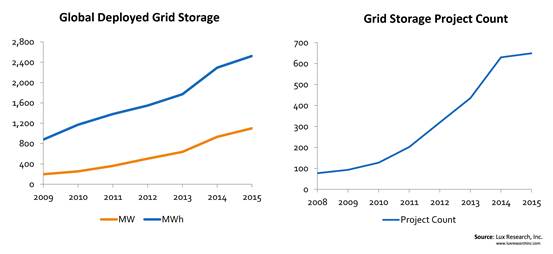Li-ion batteries dominante grid storage
Li-ion batteries have become the dominant technology in grid storage, capturing a 90% share of systems proposed last year. Molten salt batteries still account for a majority of installations by energy capacity, because of NGK Insulators’ early lead. However, according to Lux Research, these batteries are no longer the technology of choice.
Li-ion accounted for 419 MW and 1,555 MWh of proposed storage systems in 2014. But molten salt batteries, consisting almost entirely of sodium-sulfur, account for 23% of all deployed MW and 64% of deployed MWh respectively. Globally, as of January 2015, 1,100 MW and 2,523 MWh of grid storage have been deployed across 605 projects.
“Driven by renewable-connected systems and demand management, grid-scale energy storage is taking off, with 450 MW and 730 MWh of systems installed in 2014,” said Dean Frankel, Lux Research Associate.
“As the market matures, new roles along the grid storage value chain are emerging, including financiers who enable leasing services to storage developers and their end-customers as well as battery operators who manage and control a systems’ role on the electric grid.”

Lux Research analysts reviewed the grid storage market, along with accompanying technologies. Among their findings:
- Japan and U.S. hold lead. Japan maintained its lead in installed energy storage capacity with 1,174 MWh. However, the United States held global leadership in power and number of projects with 418 MW across 250 projects.
- LFP, NMC are leading Li-ion cathodes. Within the Li-ion battery chemistries, LFP (lithium iron phosphate) is the largest cathode deployed by MW and MWh, with market shares of 39% and 38.1%, respectively, followed by nickel-manganese-cobalt, which is rapidly becoming the cathode of choice among developers .
- Demand management and renewable connected systems are driving the primary grid storage applications. Demand management (376 MW and 1,335 MWh across 236 projects), driven in the U.S. by time-of-use rates and tiered pricing, and renewable connect systems (513 MW and 890 MWh across 261 projects) are the leading applications for energy storage.


